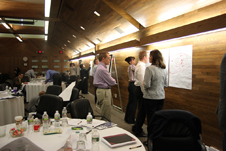October 29, 2010 Vol. 3, Issue 10
The third event in the Academy’s Knowledge Forum series addressed building and managing knowledge networks.

NASA APPEL Knowledge Forum attendees discuss building networks. Photo Credit: NASA
The Academy convened a global group of knowledge experts from government, academia, and industry to share insights and stories about knowledge sharing during the Academy’s third Knowledge Forum. The event was co-hosted by the Educational Testing Service (ETS) on Tuesday, September 21, 2010 in Princeton, New Jersey.
“A crowd is not a network” began T.J. Elliott, Chief Learning Officer at ETS. Simply connecting members in a crowd is insufficient for sharing and synergizing knowledge in networks. Most of the information that we care about is difficult to index and not all that obvious, he pointed out. Quoting authors John Seely Brown and Paul Duguid, he said, “It is not shared stories or shared information so much as shared interpretation that binds people together.”
Accomplishing a shared interpretation relies heavily upon building trust, said Emma Antunes, Web manager at Goddard Space Flight Center. She added that connections and collaborations are not the same. “Networks are me-centric,” continued Antunes. “A community has more of a sense of ownership, we-centric.” Organizations have to trust people and empower them to develop both. This trust originates from and grows with transparency, which is a matter of “matching what I say with what I do,” according to Antunes.
“People want to help out,” added Jeanne Holm, Chief Knowledge Architect at the Jet Propulsion Laboratory, who is currently serving as communications and collaborations lead for DATA.GOV. “Join the community and share what you know versus joining the community to find friends and connect with them.” Trust, tasks, and talent play significant roles in maintaining a network, she said.
Determining the work and making it explicit is also key to the success of a network, said Daniel Wilson of the Harvard Graduate School of Education. The work of a social network or a terrorist network is well defined, but what is the work of a knowledge or learning network? According to Wilson, these networks have three components: transmission, transaction, and transformation. Transmission is similar to what Facebook users do on their “walls,” explained Wilson: they broadcast lots of information through posts. Transaction occurs when a conversation begins. Transformation is where we are failing, he said, and will be the focus for improvement over the next decade.

Knowledge Forum participants put pen to paper and draw out their knowledge networks. Photo Credit: NASA
Naoki Ogiwara, Senior Consultant of Knowledge Management at Fuji Xerox, shared how his organization is creating physical spaces and environments for network building. These spaces, explained Ogiwara, are designed to enable employees to build and share social and intellectual networks related to topics such as sustainability or innovation.
The impact social media tools are having on organizational structure has triggered a shift. “I think traditional hierarchies are finished,” said Larry Prusak, Editor in Chief of ASK Magazine, suggesting that organizations are crumbling under the weight of their own hierarchies.
Klaus Tilmes, advisor to the World Bank, expressed concern about data overload. Communities are becoming accustomed to “throwing data over the fence and expecting people to do something with it,” he said. There must be a purpose behind the data flowing through networks. He provided the successful stories of the emergency response community, where social networks facilitate rapid circulation of up-to-date information.
For Rich Roberts, Senior Research Scientist at ETS, personality is among the most important factors to having a successful network, especially for teams. Successful networks consist of individuals who have a good work ethic, practice effective communication, and are agreeable, emotionally stable, and open to new experiences. If you’re going to have a healthy kind of network…personality is one of the best predictors of outcomes,” he said.
At the end of the day, forum attendees each received a large Post-It® the size of a flip chart and a felt-tipped marker so they could respond to the following questions:
- When you look for new ideas, to whom do you turn and what tools (if any) do you use?
- When you have something to share, with whom do you share and how do you share it?
- When you need to solve a problem, to whom do you turn and what tools do you use?
Participants were asked to visually represent their answers on paper. Everyone was given ten minutes before all the charts were displayed on the walls for everyone to view and compare. Walking around the room, participants immediately noticed that no two drawings looked alike. Some 30-plus participants had visualized and drawn their go-to knowledge network differently.
On a majority of the posters, social media figured prominently as a source or tool for finding or sharing new ideas. Many participants said that the depiction of their network depended on the topic or question. Upon reflection, many agreed that an important consideration for tapping into knowledge networks is the approachability of people within a network. As people become more accessible and more findable, the issue of privacy rears its head.





